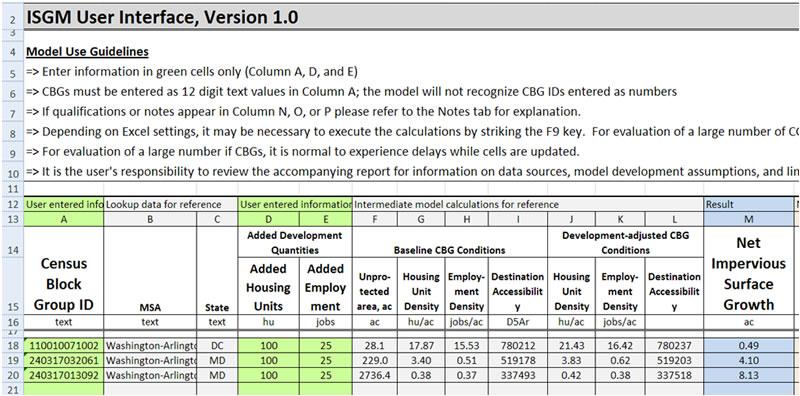Impervious Surface Growth Model
Stormwater runoff is a major contributor to water pollution.1 When rainwater washes over impervious surfaces such as rooftops, parking lots, and roads, it collects and carries pollutants that ultimately flow into waterways. Smart growth strategies can help to reduce the impact of new development on stormwater runoff by preserving open spaces and focusing new construction in developed areas, which reduces the amount of new impervious surface per unit of development.
For more information on how development patterns affect stormwater runoff, please see the EPA publications Protecting Water Resources With Higher-Density Development and Using Smart Growth Techniques as Stormwater Best Management Practices.
Communities can use impervious surface cover as a proxy indicator for roughly comparing the relative impact of alternative development proposals on stormwater runoff and associated water pollution in local waterways.2
EPA created the Impervious Surface Growth Model (ISGM) to help communities estimate and compare the likely impervious surface impacts of proposed housing and commercial development scenarios. The ISGM spreadsheet tool is well suited for sketch planning applications when more detailed and site-specific stormwater runoff analysis is not possible. Analysts can also integrate ISGM with other tools for more detailed studies of stormwater and water quality impacts.
One key feature of ISGM is the supporting database. The ISGM spreadsheet tool is pre-loaded with baseline data for all U.S. census block groups.3 Communities can use ISGM without the need for additional baseline data or calibration for the local area of analysis.
Users of the ISGM spreadsheet tool provide the following inputs:
- Census block group 3 identifier (use the Census Block Group ID Finder to look up).
- Census block group FIPS code (use this tool to find the FIPS code for your location Exit)
- Number of new homes proposed to be built in the block group.
- Number of new jobs (post-construction) expected to be located in the block group
The ISGM spreadsheet then calculates acres of new impervious surface associated with the development scenario. Below is a screenshot of the ISGM spreadsheet user interface. Columns in green accept user input. The blue column shows the resulting calculation.

One unique feature of ISGM is its sensitivity to development location. This tool models impervious surface growth based on density of housing and jobs as well as destination accessibility (the relative centrality within the surrounding metropolitan region). Baseline data for each of these variables comes from EPA’s Smart Location Database.
- Download the ISGM spreadsheet and supporting database (XLSX). Note this is a large file. Download time will vary based on the speed of your internet connection.
- Download the article, A Place-Based Tool for Assessing Cumulative Impervious Surface Outcomes of Proposed Development Scenarios, which appears on page 25 of URISA Journal (PDF) (78 pp, 11.5 MB, About PDF) Exit. The article describes the impetus for ISGM, model development, intended uses, limitations, and some anticipated future enhancements.
1 U.S. Environmental Protection Agency. National Water Quality Inventory Report to Congress. 2004, p. 12.
2 Arnold, C. L., & Gibbons, C. J. “Impervious Surface Coverage: The Emergence of a Key Environmental Indicator.” Journal of the American Planning Association. 1996, 62(2), pp. 243-258.
3 Block groups are contained within census tracts and generally contain between 600 and 3,000 people, with an optimum size of 1,500 people. The land area of block groups varies based on population density.
